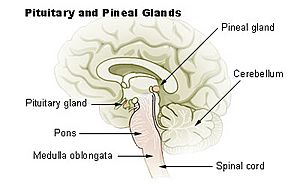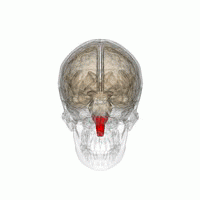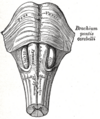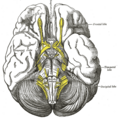Medulla oblongata facts for kids
The medulla oblongata, often just called the medulla, is a very important part of your brainstem. It sits right above your spinal cord and connects the higher parts of your brain to the spinal cord. Think of it like a bridge that helps messages travel back and forth.
The medulla is like the control center for many things your body does automatically. It helps manage your heart rate, blood pressure, breathing, and even the size of your blood vessels. Without the medulla working properly, your body wouldn't be able to do these vital jobs, which would be very serious.
Contents
What the Medulla Does
The medulla has many crucial roles. It acts as a relay station, sending nerve signals between your brain and spinal cord. Signals from your brain tell your body what to do, like moving your arm. Signals from your spinal cord tell your brain what's happening in your body, like if you touch something hot. The medulla makes sure all these messages get through.
It also controls many automatic functions – things your body does without you even thinking about them!
Controlling Your Breathing
Your medulla is in charge of your breathing. Special groups of neurons (nerve cells) in the medulla tell your body when to breathe in, when to breathe faster, and when to breathe slower.
The medulla constantly checks how much carbon dioxide is in your blood. When your body uses energy, it creates carbon dioxide as a leftover. Your body needs to get rid of this extra carbon dioxide because too much of it can be harmful. The only way to get rid of it is by breathing it out.
If there's too much carbon dioxide in your blood, the medulla sends signals to your breathing muscles. It tells them to work harder, making you breathe faster. This helps you breathe out the extra carbon dioxide. Once the carbon dioxide levels are back to normal, the medulla tells your body to breathe slower again.
Controlling Your Heart
The medulla also helps control two important systems: the sympathetic nervous system and the parasympathetic nervous system. These systems work together to manage many body functions, like how fast your heart beats and how hard it pumps blood.
Inside the medulla's "cardiac center," there are special nerves. Some are "excitatory nerves" that make your heart beat harder and faster. Others are "inhibitory nerves" that make your heart beat slower and less hard.
If your blood pressure gets too low, the cardiac center sends a message to the excitatory nerves. They tell your heart to beat faster and harder, which helps raise your blood pressure. If your blood pressure gets too high, the cardiac center sends a message to the inhibitory nerves. These nerves slow your heart down and make it pump less hard, which lowers your blood pressure. The medulla helps keep your blood pressure just right.
Controlling Blood Vessels
The "vasomotor center" in the medulla controls the size of your body's blood vessels.
When you are stressed or in danger, this center can make your blood vessels get smaller. This is part of your body's "fight or flight" reaction. It sends more blood to your most important organs, like your brain, heart, and lungs. This can help you react quickly in a dangerous situation. It also makes your blood pressure go up.
At other times, the vasomotor center can make your blood vessels get wider. This lowers your blood pressure and makes it easier for blood to reach other parts of your body.
Controlling Reflexes
The medulla also controls some important reflexes. These are automatic actions your body does without you thinking. Some examples include vomiting, coughing, sneezing, and swallowing.
Other Important Jobs
Groups of neurons in the medulla also help control other important things. These include your body's movements, how you digest food, and even your sleep patterns.
What Happens if the Medulla is Injured
Because the medulla controls so many vital functions, injuries to this part of the brain can cause very serious problems.
For example, an injury to the middle of the medulla might cause these symptoms:
- Paralysis (not being able to move) on one side of the body.
- Paralysis of part of the tongue.
- Losing the sense of touch (not being able to feel anything).
- Losing the sense of position (not knowing where your body parts are without looking).
An injury to one side of the medulla might cause these symptoms:
- Trouble swallowing.
- Dizziness.
- Vomiting.
- Losing the ability to feel pain or temperature.
- Losing your gag reflex.
If a person's medulla is completely damaged, for example, from a very bad injury or if it doesn't get enough oxygen, the person will not be able to survive.
Images for kids
-
Medulla animated as it comes out of the foramen magnum (a hole at the base of the skull), where it then becomes the spinal cord.
See also
 In Spanish: Bulbo raquídeo para niños
In Spanish: Bulbo raquídeo para niños








